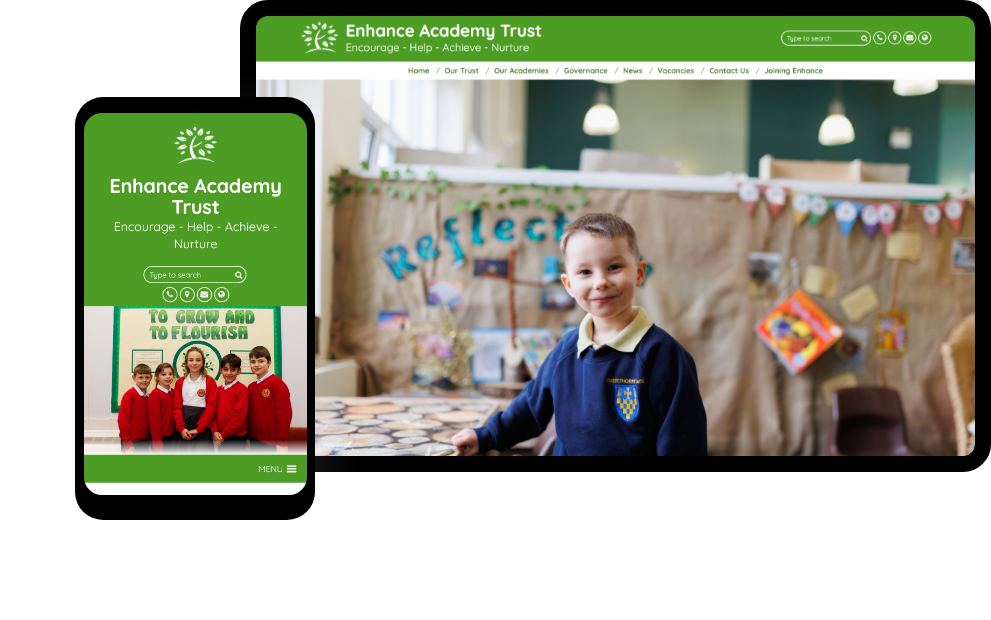Digital marketing is essential in today’s educational landscape, transforming how multi-academy trusts communicate and engage with their audiences. As more families turn to online resources to make educational decisions, having a robust digital presence is key.
This article will delve into seven critical digital marketing strategies tailored for multi-academy trusts. Each marketing strategy is designed to boost visibility and significantly enhance enrolment and community interaction.
Building an Engaging, User-Friendly Website
A website acts as the digital face of any multi-academy trust. A multi-academy trust website must be designed to be user-friendly and accessible on all devices, including smartphones. An intuitive, easy-to-navigate site ensures that parents, students, and staff can find the information they need quickly and effortlessly. This accessibility not only enhances the user experience but also supports better engagement with your trust’s educational offerings and community initiatives.
Implementing Effective SEO Strategies
For multi-academy trusts, implementing tailored SEO tactics is vital to enhance visibility in search engine results, making your institutions easily discoverable by prospective students and parents. Begin with thorough keyword research to understand your audience’s terms when searching for educational options. Incorporate these keywords naturally into high-quality content, titles, and meta descriptions to boost on-page optimisation.
Pay attention to the power of local SEO. Ensure that each academy within the trust optimises its listings for local searches. This includes accurate Google My Business entries, local keywords, and location-specific content, which can significantly increase each academy’s visibility in its respective community.
Leveraging Social Media to Build Community
Social media is a dynamic tool for multi-academy trusts, serving as a bridge to connect with students, parents, and local communities. These platforms offer a unique space for interactive engagement and real-time communication, enhancing the sense of community and belonging.
When selecting platforms, consider where your target audience is most active—whether it’s Facebook for parents or Instagram and Snapchat for students. Maintain a consistent posting schedule to keep your audience engaged and informed.
Using interactive content such as polls, live videos, and Q&A sessions to encourage participation and foster a more connected community atmosphere is essential. This approach boosts engagement and strengthens the trust’s presence in the digital world.
Utilising Content Marketing to Showcase Expertise
Content marketing is crucial for multi-academy trusts looking to establish themselves as thought leaders in the education sector. You can demonstrate your expertise and commitment to educational excellence by sharing insightful and valuable content.
To effectively engage your target audiences, diversify your content types. Develop informative blogs that address common questions or concerns, send out newsletters highlighting successes and upcoming events, and create video tutorials offering educational support or showcasing day-to-day activities at your academies. Each piece should provide real value, aiming to inform, educate, or solve problems, reinforcing the trust’s reputation as a leader in the field.
Enhancing Engagement with Email Marketing
Email marketing remains a powerful tool for multi-academy trusts, allowing for direct and personalised communication with parents, students, and staff. It’s an efficient way to disseminate information, from academic updates to event notifications.
To maximise the effectiveness of your email campaigns, start by segmenting your mailing lists. This means organising your contacts into groups based on criteria like age, enrolment status, or specific interests, which ensures that recipients receive relevant content. Personalise your emails to create a connection; including the recipient’s name can increase engagement.
Automation tools can also schedule emails for upcoming events or regular updates, ensuring consistent communication without constant manual input. These strategies help maintain an organised, impactful communication flow that resonates with each segment of your community.
Using Paid Advertising to Boost Enrolment
Paid advertising is an effective accelerator for boosting enrolment within multi-academy trusts. Leveraging PPC campaigns and targeted social media ads, you can directly reach those actively searching for educational opportunities.
To get the most out of your advertising budget:
- Focus on targeting.
- Use PPC ads in search engine results when prospective students and parents are looking for schools in your area.
- For social media, customise your ads to appeal to specific demographics within geographical limits, ensuring your message reaches those most likely to enrol.
Carefully selecting your target audience and crafting compelling ads that speak to their needs and aspirations will help you increase the visibility and attractiveness of your academics.
Analysing and Adapting Strategies with Analytics
Data is the backbone of any successful digital marketing strategy. Analytics tools are invaluable as they provide insights into website traffic, user engagement, and conversion rates, enabling multi-academy trusts to understand what’s working and what isn’t.
To make the most of these tools:
- Start by setting clear goals for what you want to track, such as increased website visits, longer engagement times, or higher numbers of applications.
- Regularly review the data collected to see patterns and trends.
- Use this information to refine your marketing approaches. For example, you could tweak your website layout or adjust your ad campaigns to better meet the needs of your target audience.
Continually analysing and adapting based on data can improve your ROI and ensure the effectiveness of your marketing efforts.
7 Marketing Tips for Multi-Academy Trusts
Adopting digital marketing strategies is essential for multi-academy trusts aiming to thrive in the competitive educational landscape. These strategies enable trusts to broaden their reach, engage more effectively with their communities, and directly impact enrolment and retention rates.
We encourage trusts to embrace a dynamic and data-driven approach to their marketing efforts. Leveraging the power of digital tools and analytics helps trusts make informed decisions that resonate with their target audiences.










